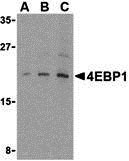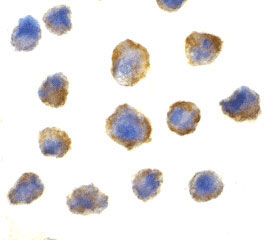4E-BP1 Antibody
- 产品详情
- 实验流程
- 背景知识
Application
| WB, ICC, E |
|---|---|
| Primary Accession | Q13541 |
| Other Accession | NP_004086, 4758258 |
| Reactivity | Human, Mouse |
| Host | Rabbit |
| Clonality | Polyclonal |
| Isotype | IgG |
| Calculated MW | 12580 Da |
| Concentration (mg/ml) | 1 mg/mL |
| Conjugate | Unconjugated |
| Application Notes | 4E-BP1 antibody can be used for the detection of 4E-BP1 by Western blot at 2.5 - 10 µg/mL. Antibody can also be used for immunocytochemistry starting at 2 µg/mL. |
| Gene ID | 1978 |
|---|---|
| Other Names | 4E-BP1 Antibody: BP-1, 4EBP1, 4E-BP1, PHAS-I, Eukaryotic translation initiation factor 4E-binding protein 1, Phosphorylated heat- and acid-stable protein regulated by insulin 1, eukaryotic translation initiation factor 4E binding protein 1 |
| Target/Specificity | EIF4EBP1; |
| Reconstitution & Storage | 4E-BP1 antibody can be stored at 4℃ for three months and -20℃, stable for up to one year. As with all antibodies care should be taken to avoid repeated freeze thaw cycles. Antibodies should not be exposed to prolonged high temperatures. |
| Precautions | 4E-BP1 Antibody is for research use only and not for use in diagnostic or therapeutic procedures. |
| Name | EIF4EBP1 |
|---|---|
| Function | Repressor of translation initiation that regulates EIF4E activity by preventing its assembly into the eIF4F complex: hypophosphorylated form competes with EIF4G1/EIF4G3 and strongly binds to EIF4E, leading to repress translation. In contrast, hyperphosphorylated form dissociates from EIF4E, allowing interaction between EIF4G1/EIF4G3 and EIF4E, leading to initiation of translation. Mediates the regulation of protein translation by hormones, growth factors and other stimuli that signal through the MAP kinase and mTORC1 pathways. |
| Cellular Location | Cytoplasm. Nucleus. Note=Localization to the nucleus is unaffected by phosphorylation status. {ECO:0000250|UniProtKB:Q60876} |
For Research Use Only. Not For Use In Diagnostic Procedures.
Provided below are standard protocols that you may find useful for product applications.
BACKGROUND
4E-BP1 Antibody: The translation of mRNA in eukaryotic cells is regulated by the presence of amino acids through multiple mechanisms. One such mechanism involves the evolutionarily conserved serine/threonine kinase TOR (Target of rapamycin, also known as mTOR), which regulates cell growth and cell cycle through its ability to integrate signals from nutrient levels and growth factors. One downstream target of TOR is the eukaryotic initiation factor 4E binding protein 1 (4E-BP1) whose phosphorylation prevents its association with eIF4E, preferentially stimulating translation of mRNAs containing long, highly structured 5'-UTRs. Rapamycin inhibits TOR resulting in reduced cell growth and reduced rates of cell cycle and cell proliferationl, at least in part by inhibiting the activity of TOR towards 4E-BP1.
REFERENCES
Shah OJ, Anthony JC, Kimball SR, et al. 4E-BP1 and S6K1: translational integration sites for nutritional and hormonal information in muscle. Am. J. Physiol. Endocrinol. Metab. 2000; 279:E715-29.
Shamji AF, Ngheim P, and Schreiber SL. Integration of growth factor and nutrient signaling: implications for cancer biology. Mol. Cell 2003; 12:271-80.
终于等到您。ABCEPTA(百远生物)抗体产品。
点击下方“我要评价 ”按钮提交您的反馈信息,您的反馈和评价是我们最宝贵的财富之一,
我们将在1-3个工作日内处理您的反馈信息。
如有疑问,联系:0512-88856768 tech-china@abcepta.com.























 癌症的基本特征包括细胞增殖、血管生成、迁移、凋亡逃避机制和细胞永生等。找到癌症发生过程中这些通路的关键标记物和对应的抗体用于检测至关重要。
癌症的基本特征包括细胞增殖、血管生成、迁移、凋亡逃避机制和细胞永生等。找到癌症发生过程中这些通路的关键标记物和对应的抗体用于检测至关重要。 为您推荐一个泛素化位点预测神器——泛素化分析工具,可以为您的蛋白的泛素化位点作出预测和评分。
为您推荐一个泛素化位点预测神器——泛素化分析工具,可以为您的蛋白的泛素化位点作出预测和评分。 细胞自噬受体图形绘图工具为你的蛋白的细胞受体结合位点作出预测和评分,识别结合到自噬通路中的蛋白是非常重要的,便于让我们理解自噬在正常生理、病理过程中的作用,如发育、细胞分化、神经退化性疾病、压力条件下、感染和癌症。
细胞自噬受体图形绘图工具为你的蛋白的细胞受体结合位点作出预测和评分,识别结合到自噬通路中的蛋白是非常重要的,便于让我们理解自噬在正常生理、病理过程中的作用,如发育、细胞分化、神经退化性疾病、压力条件下、感染和癌症。







